London AGS Show, 2008
For the past 30 years I have attended this Show annually: in all that time the highlights have shifted in no predictable sequences from (for example) dionysias to daphnes, from high alpine buttercups to Mediterranean orchids, from Turkish chasmophytes to distinguished Chinese woodlanders, and from an almost complete roll-call of fritillaries and trilliums through to any number of first-rate dwarf daffodils. These displays have in chief relied on a smallish core of selfless, often seasoned exhibitors motivated much less by the prospect of ‘cleaning up’ and as such swelling their points totals, than galvanized by a dogged willingness to support the event, despite the logistical difficulties posed by a two day, midweek timetabling, a further burden on the Saturday after Saturday travelling schedule, and the several other unadvertised twists of difficulty that further complicate the innocent activity of bringing plants for display in central London.
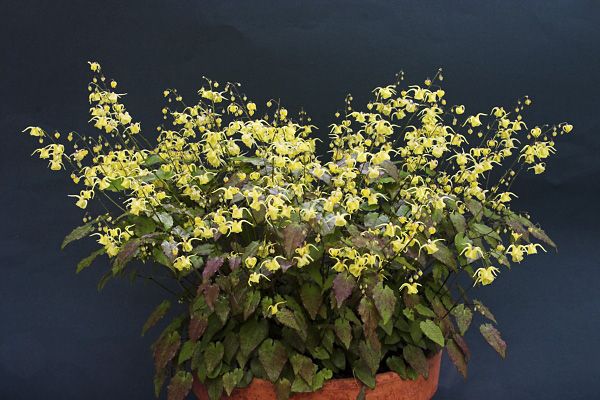 Latterly, Cecilia Coller has been the mainstay of the event, and she had an especially strong contingent of entries this time round. Her pretty-much faultless large six pan exhibit won her an RHS Sewell Medal, and featured woodlanders from several parts of the world (a strong theme within the Show overall), but with a Chinese emphasis, taking in a couple glossy-leaved asarums in peak flower, a luxuriously ruby-felted Podophyllum delavayi, and a prodigiously well-flowered Epimedium davidii (left), transported all the way from East Anglia but with not even a single sepal shed.
Latterly, Cecilia Coller has been the mainstay of the event, and she had an especially strong contingent of entries this time round. Her pretty-much faultless large six pan exhibit won her an RHS Sewell Medal, and featured woodlanders from several parts of the world (a strong theme within the Show overall), but with a Chinese emphasis, taking in a couple glossy-leaved asarums in peak flower, a luxuriously ruby-felted Podophyllum delavayi, and a prodigiously well-flowered Epimedium davidii (left), transported all the way from East Anglia but with not even a single sepal shed.
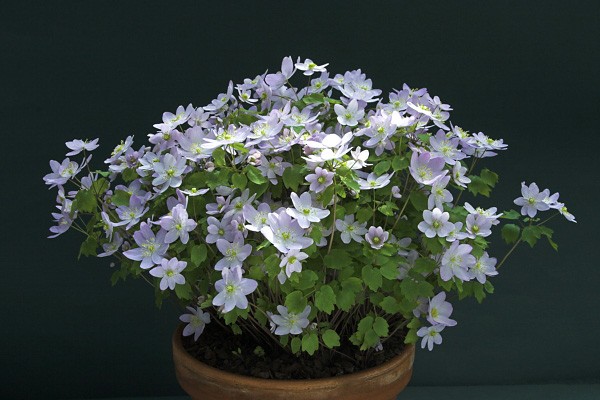 The last-named was a strong contender for the Farrer Medal and received a Certificate of Merit; another close challenge for recognition as best plant in Show came from her Anemonella thalictroides, raised from seed sown 18 years ago, which was the highlight of her 19 cm six pan display - a head-turning mound of clear pink flowers, so dense that the leaves (which later expand, as the shoots elongate, with the floral abundance overtaken as they fade, then shatter) were scarcely visible. The finest of several specimens she had brought along and showed in several classes, it won the Audrey Bartholomew Memorial Spoon for the best plant from North America, though this could equally have been awarded to either of two Sanguinaria canadensis ‘Multiplex’ (hers again!), both with their glossy white, double peony-like flowers, seen at that brief, optimum stage where they have been open only a day or two, protected from the elements (there had been an air frost the night before) and – this being congestion-charge-levied London – ‘parked’ in the central zone of the pot, not awkwardly shoved up against the pot rim, nor concertinaed after a belated lifting from the open garden, as one often sees.
The last-named was a strong contender for the Farrer Medal and received a Certificate of Merit; another close challenge for recognition as best plant in Show came from her Anemonella thalictroides, raised from seed sown 18 years ago, which was the highlight of her 19 cm six pan display - a head-turning mound of clear pink flowers, so dense that the leaves (which later expand, as the shoots elongate, with the floral abundance overtaken as they fade, then shatter) were scarcely visible. The finest of several specimens she had brought along and showed in several classes, it won the Audrey Bartholomew Memorial Spoon for the best plant from North America, though this could equally have been awarded to either of two Sanguinaria canadensis ‘Multiplex’ (hers again!), both with their glossy white, double peony-like flowers, seen at that brief, optimum stage where they have been open only a day or two, protected from the elements (there had been an air frost the night before) and – this being congestion-charge-levied London – ‘parked’ in the central zone of the pot, not awkwardly shoved up against the pot rim, nor concertinaed after a belated lifting from the open garden, as one often sees.
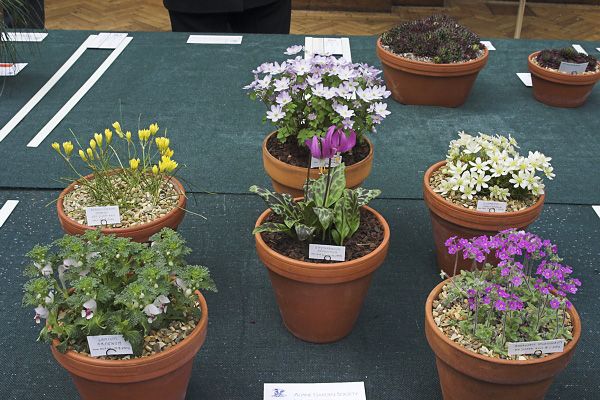 It would be possible to fill this report in its entirety with plants shown by the same exhibitor: however, on grounds of balance, and given that other exhibitors brought along memorable plants, it’s worth adding a tailpiece acknowledging her further victory with a six pan raised from seed submission, predominantly pink in hue, with a richly-coloured Erythronium revolutum, a violet-pink Anemonella thalictroides, and a purplish Androsace studiosorum of especially dwarf stature (the result of sowing home-saved seed collected from its currently popular, white flag-bearing clone ‘Doksa’) to the fore.
It would be possible to fill this report in its entirety with plants shown by the same exhibitor: however, on grounds of balance, and given that other exhibitors brought along memorable plants, it’s worth adding a tailpiece acknowledging her further victory with a six pan raised from seed submission, predominantly pink in hue, with a richly-coloured Erythronium revolutum, a violet-pink Anemonella thalictroides, and a purplish Androsace studiosorum of especially dwarf stature (the result of sowing home-saved seed collected from its currently popular, white flag-bearing clone ‘Doksa’) to the fore.
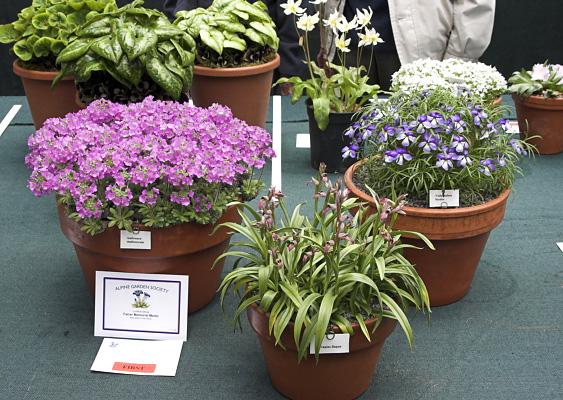 Six years ago, at the Exeter Show, Lee & Julie Martin won a Farrer Medal with the aforementioned A. studiosorum ‘Doksa’; in 2008 they brought to the London Show a 30 cm half pot overflowing with a deep rose-pink version of the species. New stolons were just emerging from the rosette bases; the trick is to use them (in early summer) to fill in any gaps in the carpeting growth as they elongate, so that they root down and form a seamless mat, as was the case with this, the best example of its type shown for many a year. It was the prime component of their three pan exhibit, alongside a bicoloured Viola pedata (also shown by several other growers) and a well-established Serapias lingua, a genus that reliably appears at this Show, though here it was the sole representative.
Six years ago, at the Exeter Show, Lee & Julie Martin won a Farrer Medal with the aforementioned A. studiosorum ‘Doksa’; in 2008 they brought to the London Show a 30 cm half pot overflowing with a deep rose-pink version of the species. New stolons were just emerging from the rosette bases; the trick is to use them (in early summer) to fill in any gaps in the carpeting growth as they elongate, so that they root down and form a seamless mat, as was the case with this, the best example of its type shown for many a year. It was the prime component of their three pan exhibit, alongside a bicoloured Viola pedata (also shown by several other growers) and a well-established Serapias lingua, a genus that reliably appears at this Show, though here it was the sole representative.
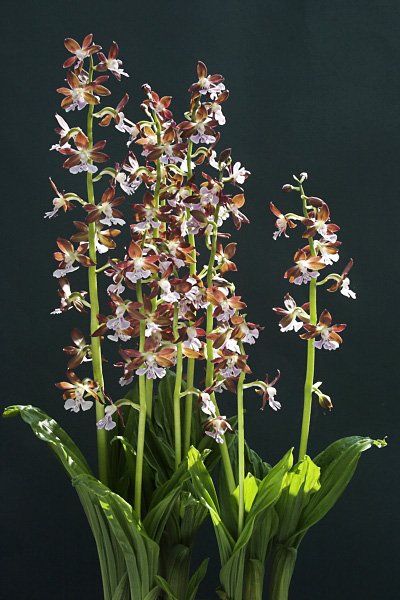 Other orchids were on parade, pleiones most numerously, and calanthes (Dick & Valerie Bathe) most impressively; a multi-spiked, red/reddish-headed, delicate violet-pink lipped C. discolor was awarded a Certificate of Merit. A second such award narrowly eluded them, for their Iris afghanica, with four flowers in prime condition but three buds yet to break, would have easily qualified if in full bloom (as was the case by the end of the second day, long after the judges had departed). This most elegant Regelia has been in cultivation almost 40 years, and a handful of specialists have made it their business to cross-pollinate the handful of clones still extant; virus-free parent stocks are now in place for seed production, which promises the wider distribution of this eminently showable species.
Other orchids were on parade, pleiones most numerously, and calanthes (Dick & Valerie Bathe) most impressively; a multi-spiked, red/reddish-headed, delicate violet-pink lipped C. discolor was awarded a Certificate of Merit. A second such award narrowly eluded them, for their Iris afghanica, with four flowers in prime condition but three buds yet to break, would have easily qualified if in full bloom (as was the case by the end of the second day, long after the judges had departed). This most elegant Regelia has been in cultivation almost 40 years, and a handful of specialists have made it their business to cross-pollinate the handful of clones still extant; virus-free parent stocks are now in place for seed production, which promises the wider distribution of this eminently showable species.
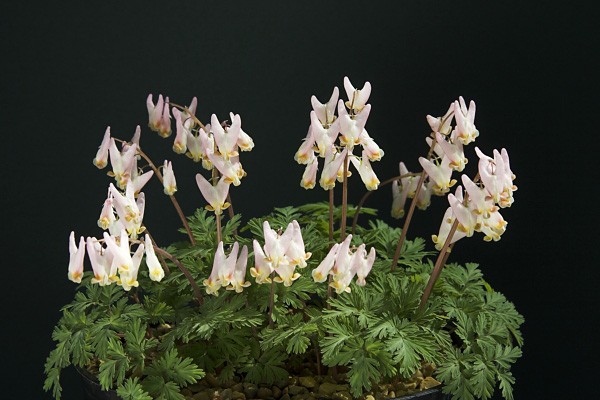 Similarly, Dicentra cucullaria ‘Carl Gehenio’ (a dwarf, truly pink selection of this predominantly white-flowered North America, named for an AGS Member from Pennsylvania and shown by Ray Drew) received a Certificate of Merit, yet his much larger, black plastic potful of Cyclamen pseudibericum, as well-flowered as any shown in recent memory, didn’t even win its class. Perhaps the very slightly pale flower colour caused reservations? Yet the corollas were still manifestly ‘fresh’; tapping them released very little of the pollen that showers from their noses once past their peak, just before the tips of the petals lose turgidity and start to wither.
Similarly, Dicentra cucullaria ‘Carl Gehenio’ (a dwarf, truly pink selection of this predominantly white-flowered North America, named for an AGS Member from Pennsylvania and shown by Ray Drew) received a Certificate of Merit, yet his much larger, black plastic potful of Cyclamen pseudibericum, as well-flowered as any shown in recent memory, didn’t even win its class. Perhaps the very slightly pale flower colour caused reservations? Yet the corollas were still manifestly ‘fresh’; tapping them released very little of the pollen that showers from their noses once past their peak, just before the tips of the petals lose turgidity and start to wither.
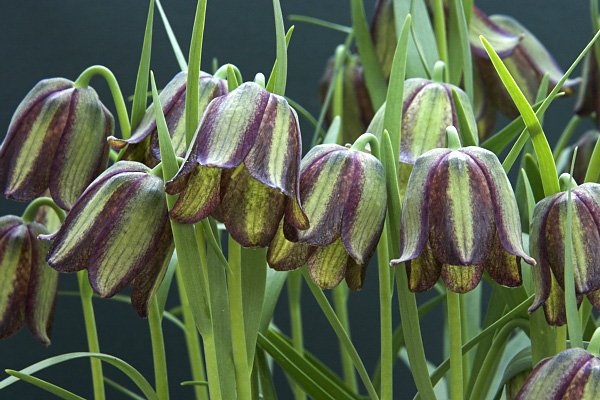 A fourth and final Certificate of Merit was unanimously voted when a surprisingly elegant Fritillaria olivieri came up for scrutiny. Unlike various rather ungainly versions of this Iranian species, some traceable to introductions made over 70 years ago, this had elegantly-flared, singly-held, vibrantly-striped blooms, and was far and away the best of the relatively few species on display this time round.
A fourth and final Certificate of Merit was unanimously voted when a surprisingly elegant Fritillaria olivieri came up for scrutiny. Unlike various rather ungainly versions of this Iranian species, some traceable to introductions made over 70 years ago, this had elegantly-flared, singly-held, vibrantly-striped blooms, and was far and away the best of the relatively few species on display this time round.
Ericaceae exhibits too were few and far between at this stage in the season (later on in the spring an improvement was evident, but the hard frosts of February and March took their toll of the first wave); happily, a low mound of pristine, reddish-brown calyced Cassiope lycopodioides ‘Beatrice Lilley’ (Richard Clements), named over 40 years ago for the wife of one-time Director of Shows Sid Lilley, and still in the first rank of clones of this long-lived, congested, Japanese/northernmost American exemplar, was a worthy candidate among the relatively few candidates on offer.
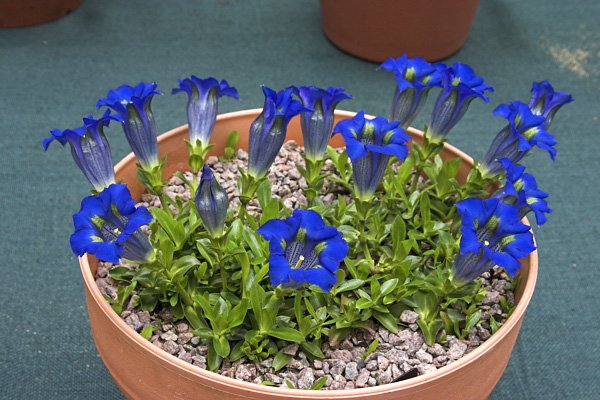 Orthodox European alpines were dotted around – P. auricula, as seen, in florist-selected forms one would seldom if ever encounter in the wild, was in good condition but scarcely counts, whereas P. hirsuta (in its oddly lime-tolerant subsp. valcuvariensis) appeared in the new and rare three pan (Ann & Michael Morton), alongside P. albenensis, (surely the finest European Primula introduction of recent years). That most silvery, most floriferous of androsaces, A. vandellii (Jim McGregor) was also present, not far from its sometime compatriot, Gentiana verna (Richard Clements), and a very creditable, freely stolon-iferous potful of a truly reliable selection of G. acaulis, ‘Froehenleiten’, that had nine deep blue trumpets at their best and a complement of buds still to break.
Orthodox European alpines were dotted around – P. auricula, as seen, in florist-selected forms one would seldom if ever encounter in the wild, was in good condition but scarcely counts, whereas P. hirsuta (in its oddly lime-tolerant subsp. valcuvariensis) appeared in the new and rare three pan (Ann & Michael Morton), alongside P. albenensis, (surely the finest European Primula introduction of recent years). That most silvery, most floriferous of androsaces, A. vandellii (Jim McGregor) was also present, not far from its sometime compatriot, Gentiana verna (Richard Clements), and a very creditable, freely stolon-iferous potful of a truly reliable selection of G. acaulis, ‘Froehenleiten’, that had nine deep blue trumpets at their best and a complement of buds still to break.
Beautiful images of these and many other alpines from as far afield as the Andes were arrayed on the far and back walls of the showhall; this visitor-thronged display owed much to the efforts of Jon Evans, who had also co-ordinated a Gold Medal-winning amalgam of photographs taken by members of the AGS Woking and West Sussex Local Groups, imaginatively portraying all manner of planting schemes and contemporary usages of alpine plants that both impressed and inspired.
